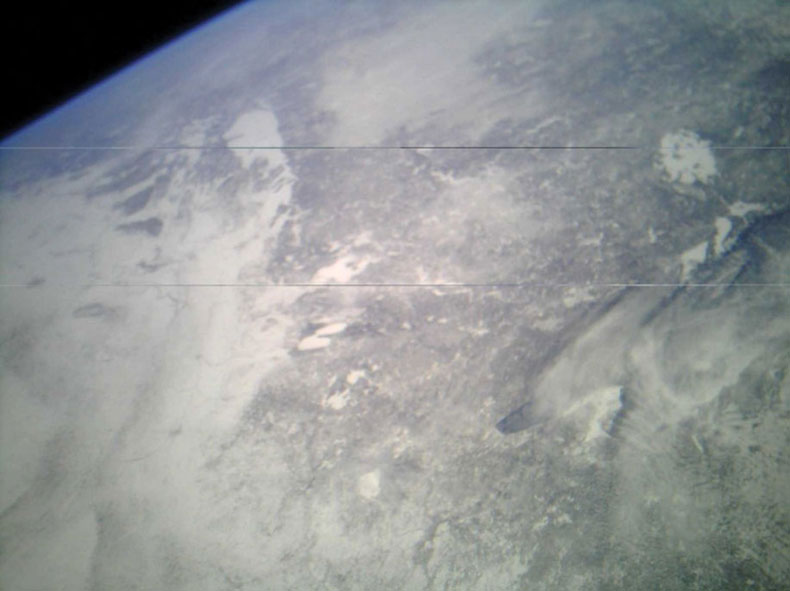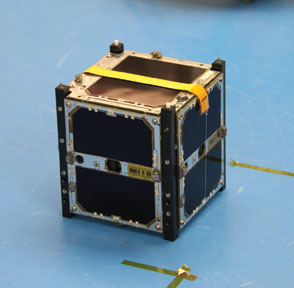CubeSat On-Board processing Validation Experiment
COVE – Validating the Instrument Processing Systems of the Future
Andrea Martin, March 2014, andrea.s.martin@nasa.gov
![]()
NASA’s Earth observing missions of the future will need to gather large quantities of high resolution data. For example, the ACE (Aerosol/Cloud/Ecosystems) mission concept will study the world’s aerosols, clouds, and ocean ecosystems by taking new, and improved, measurements on a global scale. The measurements could give scientists a clearer picture of how aerosols, both manmade and naturally occurring, are related to climate and other topics of societal concern.
ACE would utilize a multi-angle, multispectral, high accuracy polarization imager to collect high volumes of global aerosol data. In fact, the Multiangle SpectroPolarimetric Imager (MSPI), a candidate for ACE’s polarimeter, will collect 95 megabytes of data per second from each of its nine cameras. Getting that amount of data back to Earth in a timely manner is a huge undertaking.
Through an ESTO Information System’s funded project and subsequent follow-on projects, an On-Board Processing subsystem to support the MSPI candidate instrument was developed. This new technique combines a predictive real-time parameter estimation algorithm with a radiation hardened-by-design field programmable gate array. This moves the first stage of data processing to the instrument so that data can be more easily transferred back to Earth in a timely manner. Led by Paula Pingree of NASA’s Jet Propulsion Laboratory, the MSPI on-board processing technique has been developed to achieve a two orders of magnitude reduction in data rate for polametric data processing.

Image downloaded from the M3 mission used in the first on-orbit validation run of COVE: Snow covered upper Midwest and Canada on 2/11/14
(Credit: S. Kang, U. Michigan)
The data-optimization technique was demonstrated with the AirMSPI instrument that flew as part of the SEAC4RS campaign in the summer of 2013. Because of the data-reduction achieved by using the optimization project, imagery from the campaign was downloaded, processed, and distributed in under 90 minutes.
Validating technologies in the lab and air, like what has been done during the SEAC4RS flight, greatly advances the technology needed for spaceborne counterparts while lowering the risk that is often associated with technology development. But conditions are much different on Earth than they are outside of our protective atmosphere and technology needs to be fully tested in realistic operational conditions.
Radiation is just one, but very real, concern when it comes to developing spaceborne instruments and data systems. But long-term and sustained ground-based testing in emulated environmental conditions is cost prohibitive. A new satellite type is changing that. CubeSats, a type of small satellite that can be as small as 10x10x10 centimeters (a one-unit CubeSat), can be rapidly built and launched, making them a feasible way to test and validate new technologies, especially technology like the MSPI On-Board processing technique, in the realistic space environment over an extended time period.
A group of over 40 University of Michigan students have led the development and operation of the Michigan Multipurpose Minisat or M3 (pronounced M-Cubed) to carry the COVE (CubeSat On-Board processing Validation Experiment) payload into space. M3 launched on December 5, 2013 from Vandenberg Air Force Base as part of NASA’s CubeSat Launch Initiative on the National Reconnaissance Office Launch-39 Atlas V.
Now In orbit, the COVE experiment is running to validate the special radiation hardened-by-design Virtex-5QV field programmable gate array as well as the processing technique used to run the predictive algorithm that facilitates first order processing of MSPI data. Since the MSPI instrument is not designed for a CubeSat, the imagery that is being used to carry out COVE experiments is being acquired both from stored data and new imagery acquired by the CubeSat. The stored data allows for initial validation against a known product and protects against a potential in-space camera failure. The new imagery of the Earth is being collected via an Omnivision 3-megapixel 2-D imager where validation includes processing and verification of on-orbit results against the data transmitted to the ground-based testbed. Both of these sequences will validate operational requirements to verify the proper polarization parameters, essential to the data reduction, were satisfied.
To-date, M3 is healthy and beaconing telemetry from a high inclination retro-grade LEO orbit. On December 13, 2013, one week after M3 launched, an auto-run of the stored data was completed and was then validated against the ground-based test bed. Additionally, the on-board algorithm product utilizing the FPGA has been produced and validated with newly acquired imagery from orbit. By running the algorithm on-board and then achieving matching results with the on-ground testbed, level-1 requirements for the mission have been successfully met.

The M-Cubed/COVE-2 CubeSat developed by U. Michigan and JPL will advance the technology required for real-time high data rate instrument processing.
(Credit: D. Smith, U. Michigan)
In the coming months, COVE will continue to run the processing technique on newly acquired and stored images. By running the experiment over a larger period of time the FPGA will be exposed to more temperature fluctuations and radiation that will contribute to characterizing the performance of the hardware and software.
The launch of the M3 satellite carrying the COVE payload is a success in the spaceborne technology validation. The CubeSat platform is enabling students to become more involved in aerospace technology while new technologies can be tested in a realistic environment like never before. The technology demonstrated here may be applied to future Earth observations, allowing for high resolution data to be quickly returned to Earth for researchers studying our planet.
For more on COVE, visit the JPL M-Cubed/COVE project website
For more on M-Cubed and the Michigan Student Space Systems Fabrication Lab, visit the M-Cubed website